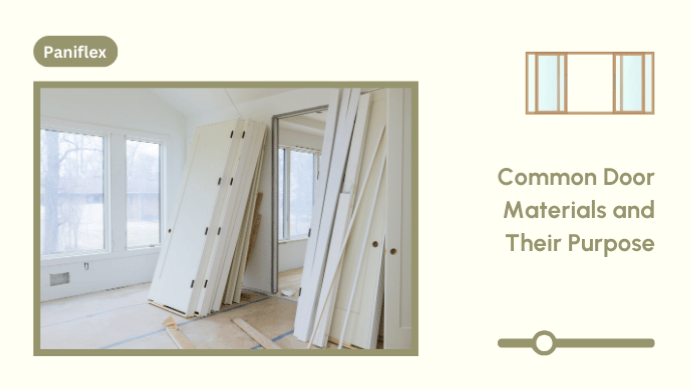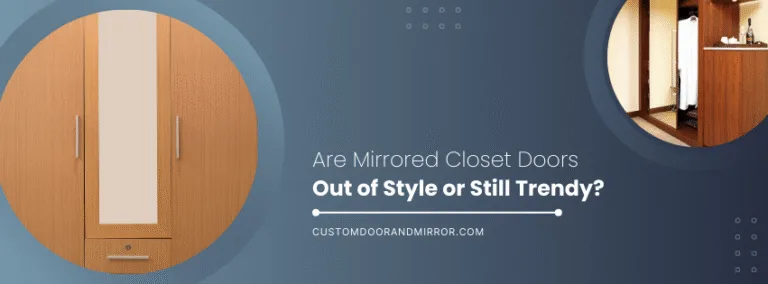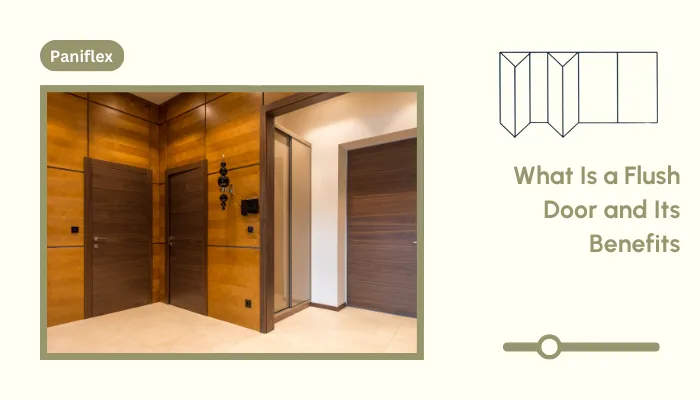It’s a common misconception that all doors are the same, but as an interior designer, you understand the significant impact that the right choice of door material can have on a project’s success. The material of a door affects every aspect, from aesthetics and durability to performance and functionality. When selecting types of door materials for new entry doors, it’s crucial to consider the design style, performance requirements, and any limitations based on the opening size.
Aesthetics play a vital role in creating a cohesive and visually appealing space, while durability ensures the door can withstand daily wear and tear. Functionality is equally important, as the door must operate smoothly and efficiently. This comprehensive guide explores the most common types of door materials and their unique purposes to help you make informed decisions in your projects.
Wood Doors
Wood doors are a popular choice among the various types of door materials for their natural beauty and versatility. Here’s what you need to know about wood doors:
- Construction: Many wood doors are made from plywood or laminate and feature a hardboard backer, with polyurethane insulation for energy efficiency. This construction helps to ensure a solid, stable door that can withstand the test of time.
- Climate considerations: In northern climates, wood doors must withstand harsh conditions that can cause moisture absorption, resulting in peeling and warping. Regular refinishing helps prevent these issues and maintains the door’s beauty and functionality.
- Solid wood doors: Crafted entirely from wood, solid wood doors provide a luxurious feel and solid security. However, they require annual maintenance to preserve their beauty and prevent damage from moisture and wear.
- Wood-panel doors: Wood-panel doors have a classic look and strong insulating properties, but they require protective finishes to preserve their appearance and durability. Without proper maintenance, these doors can be susceptible to cracking, warping, and other damage.
- Wood types: The choice of wood species significantly impacts the door’s performance and durability. Hardwoods like oak, maple, and cherry are known for their strength, resistance to wear and tear, and ability to maintain their appearance over time. On the other hand, softwoods like pine are more prone to dents, scratches, and damage from daily use. When selecting a wood type, consider the level of traffic the door will experience and the desired aesthetic.
Want to learn how to create the best customized wooden closet doors?
Steel Doors
Steel doors offer unmatched strength and security, making them a popular choice among the various types of door materials for both residential and commercial applications. Key points to consider:
- Gauge: The thickness of steel doors is measured in gauge, with lower numbers indicating thicker steel. 24-gauge steel doors provide minimum durability and are suitable for light-duty applications. However, for enhanced strength and resilience, 22-gauge doors are the preferred choice. These thicker doors are more resistant to dents, dings, and forced entry attempts, making them ideal for high-traffic areas or security-conscious projects.
- Low maintenance: Steel doors require minimal upkeep, as they can be easily painted to match any design scheme. Unlike wood doors, steel doors do not require regular refinishing or staining to maintain their appearance. This low-maintenance aspect makes steel doors a popular choice for replacements and upgrades.
- Insulation and security: Steel exterior doors offer excellent insulation properties, helping to regulate temperature and reduce energy costs. They also provide unparalleled strength and security, deterring potential intruders and providing peace of mind for both residential and commercial buildings.
Fiberglass Doors
Fiberglass doors have gained popularity among the various types of door materials for their durability, versatility, and resistance to environmental factors. Here’s what sets fiberglass doors apart:
- Low maintenance: Fiberglass doors resist denting, scratching, and weathering, requiring minimal maintenance to maintain their appearance. They don’t require finishing for maintenance, making them a hassle-free choice for busy households or commercial spaces.
- Realistic wood grain: High-quality fiberglass doors, like those with Therma-Tru’s patented AccuGrain technology, provide a stunning wood-like appearance that is virtually indistinguishable from real wood. This technology creates a detailed, realistic grain pattern that mimics the look and feel of natural wood without the maintenance demands.
- Longevity: Fiberglass doors are known for their long-lasting performance, as they resist deterioration and maintain their beauty for years without the need for constant upkeep. Unlike wood doors, fiberglass doors do not absorb moisture, which helps prevent warping, cracking, and other damage over time.
- Moldability: One of the key advantages of fiberglass doors is their moldability. This allows manufacturers to create intricate designs, detailed panel profiles, and even custom shapes that mimic the look of traditional wood doors. This moldability enables interior designers to achieve a specific aesthetic without sacrificing durability or performance.
Ready to experience the benefits of custom closet doors? Explore our range of Paniflex products now.
Other Door Materials
In addition to wood, steel, and fiberglass, there are several other types of door materials to consider:
- Laminate doors: Laminate doors are available with exotic designs at an affordable price point, making them an attractive option for interior applications. These doors feature a thin layer of printed or colored laminate applied over a core material, such as MDF or particleboard. While laminate doors offer a wide range of design possibilities, they are best suited for interior use, as they may not withstand exterior elements as well as other materials.
- Hollow metal doors: Hollow metal doors are highly durable and versatile, making them suitable for various applications, including commercial and industrial settings. These doors feature a hollow core construction, which provides strength and stability without excessive weight. Hollow metal doors are often used in areas where security, fire resistance, and sound insulation are top priorities.
- Stave-core doors: Also known as core-block doors, these extremely stable doors are made from laminated thin pieces of wood. The individual wood staves are arranged vertically and bonded together, creating a door that is resistant to warping, twisting, and bowing. Stave-core doors offer excellent dimensional stability and are often used in high-end residential and commercial projects.
- Medium-density fiberboard (MDF) doors: MDF doors are growing in popularity for interior use due to their affordability, consistency, and versatility. Made from wood fibers compressed under high pressure and bonded with resin, MDF doors provide a smooth, seamless surface that is perfect for painting or laminating. They are available in a wide range of styles, from simple flat panels to intricate molded designs, making them a great choice for interior applications where a specific aesthetic is desired.
Special Considerations
When selecting types of door materials, keep these special considerations in mind:
- Glass doors: For exterior use, glass doors require a well-built structure and proper insulation to ensure energy efficiency and durability. It’s crucial to follow recommendations for insulation and choose energy-efficient glazing to prevent heat loss and maintain a comfortable indoor environment. Double or triple-paned glass with low-E coatings can significantly improve the door’s thermal performance, reducing energy costs and enhancing overall comfort.
- Moisture issues: Materials like laminate and plywood can absorb moisture, leading to peeling, swelling, or warping. These issues are particularly common in high-humidity environments or areas exposed to frequent moisture, such as bathrooms or coastal regions. When choosing these materials, consider the environment and exposure levels to avoid premature deterioration. In moisture-prone areas, opt for materials that are specifically designed to resist moisture damage, such as fiberglass or properly sealed and finished wood doors.
- Protective finishes: Applying protective finishes is essential to prolong the life and maintain the beauty of wood doors. Regularly refinishing wood doors helps prevent moisture damage, protects against scratches and dents, and preserves their natural appearance. A high-quality, durable finish, such as a polyurethane or lacquer, can provide long-lasting protection and enhance the door’s overall performance. Be sure to follow the manufacturer’s recommendations for refinishing intervals and techniques to ensure the best results.
Conclusion
Choosing the right types of door materials is crucial for creating functional, durable, and visually appealing spaces. By understanding the unique characteristics, benefits, and limitations of each material, interior designers can make informed decisions that align with their project’s requirements and clients’ needs.
However, it’s important to remember that the quality of a door depends not only on the material but also on proper installation. Cheap, low-quality doors may seem like an attractive option for short-term savings, but they can lead to costly repairs, energy inefficiencies, and even safety concerns down the line. As an interior designer, it’s your responsibility to guide clients toward high-quality, durable options that will stand the test of time. Investing in proper installation and avoiding subpar materials will ensure the longevity and performance of the doors, ultimately saving your clients money and headaches in the long run.
For expert guidance and premium door solutions, turn to Paniflex. With their extensive range of types of door materials and custom options, you can create doors that perfectly align with your design vision and meet the unique needs of your projects. Their commitment to quality, precision, and customer satisfaction ensures that every door is crafted to the highest standards and installed with meticulous attention to detail. Explore their collection today and elevate your projects to new heights with doors that seamlessly blend form and function.






